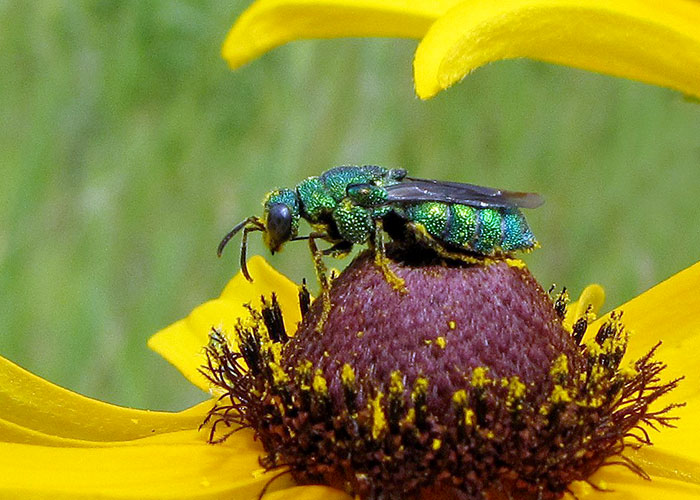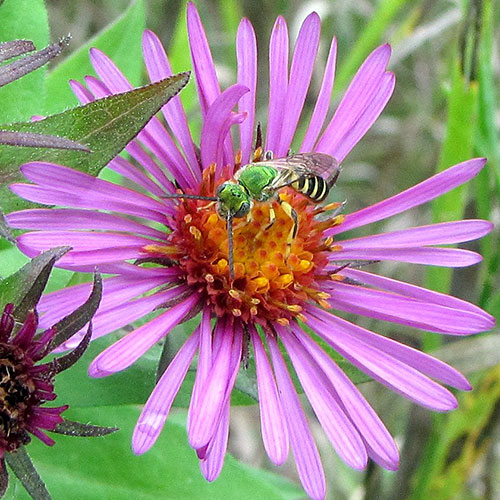Greetings, BugFans,
Cuckoo Wasps
It’s always a treat finding a flower that is inhabited by one of these small, glittering, secretive, wasps. Cuckoo wasps are classified in the family Chrysididae, in the order Hymenoptera, and they are sometimes called Gold Wasps, Emerald Wasps or Jewel Wasps. The family name comes from the Greek, chryso, meaning gold. Besides green, they come in red, blue and purple and the thick cuticle of their exoskeleton (they are described as “heavily armored”) is often “pitted.” The common name refers to their habit of depositing their eggs in other insects’ nests; a strategy practiced by birds like the Old World Cuckoos and the New World Cowbirds. Some sweat bees (also pictured) look similar, but cuckoo wasps tend to be “chunkier.”
Cuckoo wasps are found worldwide except, understandably, in Antarctica. There are about 230 species north of the Rio Grande, and California is especially cuckoo-wasp-rich (settle down, the BugLady is just talking about Insects, here).
So, the female Cuckoo wasp uses her strong jaws to gain entrance to a host’s nest while the host is out. There she lays her eggs. The larvae of some species of cuckoo wasps feed on the larvae of the nest-builder, usually another wasp, a bee, a silk moth or a walking stick. Species that operate this way are called parasitoid (like the tachinid flies of previous BOTW fame); they eat their hosts from the outside and then pupate outside their host. Other kinds of cuckoo wasp larvae are cleptoparasites (really!), which hatch in the host’s nest (usually other kinds of solitary wasps) and, of course, proceed to “liberate” the food (dead insects and spiders) that the host has cached for her young. For the victim, either kind of attention means death. The adults feed on nectar and sometimes on the honeydew produced by aphids, and they are important pollinators.
According to Swain, in The Insect Guide, the adults of cuckoo wasps’ potential hosts may recognize and attack them. That’s where the armor comes in. Their extra-tough cuticle protects them from being bitten and stung by the home-owner. The lower surface of their abdomen is concave, which allows them to fold “in half,” snugging their abdomen against their head and thorax. In a pinch, Cuckoo wasps roll up in a ball and stay still.
Cuckoo wasps, like the majority of bees and wasps, are solitary. In highly social species like honeybees and paper wasps, there is a caste system. Since the queen is the only female that lays eggs, she is the only one outfitted with an ovipositor. And, since part of their job is defense, the workers’ vestigial ovipositors have been modified into stingers. Solitary wasps need ovipositors, and many (but not all) sources say that cuckoo wasps have lost the ability to sting.
The BugLady

